Can You Build Muscle and Lose Fat at the Same Time? A Comprehensive Guide
Many people wonder if it’s possible to gain muscle and lose fat at the same time. The answer is yes, with the right approach. To achieve this dual goal, you need to create a calorie deficit while also getting enough nutrients to support muscle growth. This means eating fewer calories than you burn but ensuring those calories are packed with what your body needs. It’s a balancing act between reducing calorie intake, increasing your protein intake, and adjusting your fat intake to lose fat tissue while striving for a lean and muscular build.
Strength training plays a crucial role in body recomposition. Exercises like weight lifting target various muscle groups and help to build strength. Compound movements, which work multiple muscle groups at once, are especially effective. They not only maximize muscle engagement but also burn more calories than isolated exercises. Incorporating exercises like the rowing machine can further enhance your workout by engaging many muscles simultaneously and lifting weights regularly is essential to stimulate muscle growth.
Finally, nutrition cannot be overlooked. Eating a high-protein diet is critical for supporting muscle protein synthesis, which is the process your body uses to build muscle. Including a variety of protein sources in your diet ensures your muscles get the fuel they need, especially when combined with healthy fats and a well-rounded approach to your overall calorie intake. With these strategies, it’s possible to lose fat and gain muscle simultaneously, transforming your body composition over time.
Understanding Body Recomposition: The Basics
At its core, body recomposition is about changing your body fat percentage and increasing your skeletal muscle mass. This means you are losing fat and gaining muscle at the same time. It’s a more refined approach than simply losing weight because it focuses on improving your body’s composition, not just reducing the number on the scale. This process requires a precise balance of nutrition, exercise, and rest to successfully shift the scales in favor of muscle over fat.
The Dual Goal: Losing Fat and Gaining Muscle
Achieving the dual goal of losing fat and gaining muscle requires a well-rounded approach. Incorporating low-intensity steady state (LISS) cardio, like walking or cycling, can help with fat loss without putting too much strain on your body. Meanwhile, focusing on strength training can increase your heart rate and improve overall fitness, which is beneficial for muscle building. This balanced approach not only supports physical health but also boosts mental health, contributing to an improved sense of well-being and dedication to men’s health and fitness goals.
How Body Recomposition Differs from Traditional Weight Loss
Body recomposition sets itself apart from traditional weight loss by prioritizing the preservation and growth of skeletal muscle mass while reducing body fat percentage. Instead of aiming for a lower number on the scale, the goal is to lose fat while gaining muscle. This approach leads to a stronger, more toned physique rather than simply a thinner one. It requires a strategic approach to both diet and exercise, with a focus on maintaining muscle mass while in a calorie deficit, which is the key to successful body recomposition.
The Role of Nutrition in Body Recomposition
Nutrition is the backbone of body recomposition. It’s not just about eating less; it’s about eating right. The proper balance of macronutrients – proteins, carbohydrates, and fats – is essential for fueling muscle growth while simultaneously shedding fat. Protein, in particular, is crucial because it supports muscle repair and growth. Carbohydrates provide the energy needed for workouts, and fats are important for hormone production and overall health. Getting this balance right is the key to transforming your body.
Protein Sources: Fueling Muscle Growth While Dieting
For muscle growth, protein is the star of the show. It’s the building block of muscle, and ensuring you have enough protein in your diet is crucial for muscle protein synthesis. This process is what your body uses to repair and build muscle fibers after a workout. Choosing high-quality protein sources like chicken, fish, beans, and lentils can make a significant difference in your body recomposition efforts.
Optimal Protein Intake for Muscle Gain
An optimal protein intake is essential not only for muscle gain but also for overall mental health. Consuming enough protein can help you feel fuller longer, manage cravings, and maintain energy levels, making it easier to stick to your diet and workout plan. The amount of protein you need can vary based on your body weight, the intensity of your workouts, and your overall goals, but aiming for a high-protein diet is a good rule of thumb for anyone looking to gain muscle and lose fat.
Balancing Macronutrients for Fat Loss and Muscle Gain
To change your body, eating the right mix of nutrients is key. Think of your body like a car. For it to run well, it needs the right kind of fuel. To lose body fat and increase muscle mass, you need a balance of proteins, fats, and carbs. Proteins are like the workers that help build your muscles. Carbs are the energy you burn to keep going. Fats are important too, but you have to choose the right kinds. Eating this way helps you get stronger and leaner at the same time.
Strength Training: The Foundation of Body Recomposition
Strength training is like the secret ingredient to changing your body. It’s not just about lifting weights; it’s about making your muscles work harder to get stronger. When you do this, your muscles grow, and you burn more calories even when you are not working out. This is because muscle uses more energy than fat. So, by building muscle, you help your body burn more calories all day long. This makes strength training a must-do for anyone wanting to get leaner and more muscular.
Key Strength Training Exercises for Building Muscle
There are some exercises that are great for building muscle. Squats, push-ups, and deadlifts are like the superheroes of the exercise world. They work a lot of muscles at the same time. This means you get a big calorie burn and build strength all over. Adding these exercises to your routine will help you get stronger and build muscle faster.
Compound Movements: Maximizing Muscle Engagement
Compound movements are exercises that use more than one muscle group at a time. Think of them as multitasking for your workout. When you do a squat, you’re not just working your legs, but also your back, your core, and even your arms a bit. This means you get a bigger calorie burn from doing these exercises. Plus, they help you build strength in a way that’s useful for real life, because in real life, we use many muscles at once, not just one at a time.
Creating a Body Recomposition Workout Schedule
When you’re looking to change your body by losing fat and gaining muscle at the same time, setting up a workout schedule is key. This plan should include days for strength training, which is essential for building muscle. You’ll want to focus on exercises that work multiple muscle groups at once. But, it’s also important to give your body time to rest. Mixing in rest days helps your muscles recover and grow stronger. For best results, aim to train each muscle group two to three times a week and adjust as you progress.
The Importance of Recovery in Body Recomposition
Recovery is just as important as your training plan when it comes to body recomposition. Your muscles need time to repair and grow after workouts. If you don’t give your body time to recover, you might stop seeing progress or even get hurt. Recovery doesn’t mean doing nothing. You can still be active in ways that help your body heal, like stretching or walking. Remember, taking care of your body helps you get closer to your goals.
Rest and Muscle Recovery: Why It’s Crucial
Rest days are a must in any fitness journey, especially when you’re trying to change your body’s composition. During rest, your muscles repair the tiny tears that happen during strength training. This process is what makes your muscles grow stronger and bigger. Not giving your body enough time to recover can lead to overtraining, which might slow down your progress. So, listen to your body and make sure to include rest days in your routine for muscle recovery and growth.
Active Recovery Techniques and Their Benefits
Active recovery is a gentle way to help your muscles heal while keeping you moving. Techniques like light walking, yoga, and swimming increase blood flow to your muscles without putting too much strain on them. This kind of movement helps get rid of the lactic acid that builds up during intense workouts, which can reduce muscle soreness. Including active recovery in your schedule can speed up the healing process and improve your overall heart health, making it easier to stick to your fitness goals.
Advanced Strategies for Body Recomposition
As you get more into your body recomposition journey, you might want to try some advanced strategies to keep seeing results. This includes changing your training program based on your training status, and adjusting your energy restriction and expenditure. For example, every 10 weeks, you could change the number of sets, reps, or even the type of exercises you do. This keeps your body guessing and helps you push past plateaus. Remember, the goal is to find a balance that works for you and keeps you moving forward.
Manipulating Training Variables for Continued Progress
To continue making progress in your body recomposition, it’s important to regularly change your training variables. This means adjusting things in your training program like how much weight you lift, how many reps you do, and how long you rest between sets. By changing these factors, you challenge your muscles in new ways, which can help you keep gaining muscle and losing fat. It’s a smart idea to review and adjust your training plan every 10 weeks to align with your current fitness level and goals.
The Role of Cardio in Losing Fat and Gaining Muscle
Cardio plays a vital role in losing fat while trying to gain muscle. Incorporating activities that raise your heart rate, like low-intensity steady state (LISS) cardio, can help create a caloric deficit. This means you’re burning more calories than you’re eating, which is necessary for fat loss. For those particularly focused on men’s health or managing conditions like overweight or obesity, cardio also boosts heart health and overall fitness. The key is to balance cardio with strength training to support muscle growth and fat loss.
Tracking Your Body Recomposition Progress
Keeping track of your progress is important when you’re working on changing your body. This doesn’t just mean watching the scale. Since you’re aiming to lose fat and gain muscle, you might not see big changes in your weight right away. Instead, focus on how your clothes fit, take body measurements, and take note of improvements in your strength and fitness. These indicators can give you a better idea of how you’re doing and keep you motivated.
Effective Methods to Measure Fat Loss and Muscle Gain
When you’re working on losing fat and gaining muscle, measuring your progress can be tricky. Instead of just relying on the scale, consider methods like body fat percentage measurements and progress photos. These tools can show changes that aren’t always visible on the scale. Also, paying attention to how your strength and endurance improve over time can be a good indicator of muscle gain. Mixing these methods can give you a fuller picture of your progress and encourage healthy eating and exercise habits.
Setting Realistic Goals and Expectations
Setting realistic goals is crucial for success in body recomposition. It’s important to understand that changes won’t happen overnight. Aim for small, achievable targets, like improving your strength in a particular exercise or slightly reducing your body fat percentage over time. Celebrate these small victories to stay motivated. Remember, consistency and patience are key. By setting realistic expectations, you’re more likely to stick with your plan and see results.
Nutrition Optimization for Body Recomposition
What you eat plays a big role in changing your body’s composition. Research has shown that maintaining an energy balance is crucial. This means eating enough to support muscle growth but not so much that you gain fat. High-quality proteins, healthy fats, and complex carbohydrates should make up the majority of your diet. Paying attention to your nutrition can make a big difference in your results, helping you gain muscle and lose fat more effectively.
Timing Your Meals Around Workouts for Optimal Results
To get the most out of your workout plan, it’s smart to time your meals to support your training status. Eating a meal or snack that’s rich in protein and carbs before and after your workouts can help with muscle recovery and growth. This strategy can also help you moderately decrease your body fat by burning calories more efficiently during and after exercise. Tailoring your nutrition in this way supports your body’s needs and can enhance your overall results.
Supplementation: Helpful or Hype?
When it comes to supplements, it’s important to approach them with a critical eye. While some can support your fitness goals, like protein powders for muscle repair, others might not be as beneficial as they claim. Always do your research and consider your own dietary needs before adding supplements to your routine. Remember, supplements should complement, not replace, a balanced diet. Consulting with a healthcare professional can also provide personalized advice.
Overcoming Plateaus in Body Recomposition
Hitting a plateau is common when you’re working on changing your body. When this happens, it’s time to reassess your exercise habits and nutrition. Sometimes, making small tweaks to your routine, like increasing the intensity of your workouts or adjusting your calorie intake, can help reignite progress. Remember, plateaus are a normal part of the journey. The key is to stay flexible and keep experimenting to find what works best for you.
Adjusting Your Strategy When Progress Stalls
If you find that you’re not making the progress you expected, it might be time to adjust your strategy. Take a close look at your exercise habits and nutrition to see where changes can be made. Maybe you need to switch up your workouts or fine-tune your diet. Listening to your body and being willing to make changes is important. With persistence and a bit of creativity, you can overcome plateaus and continue moving towards your body recomposition goals.
The Psychological Aspect of Body Recomposition
Changing your body is not just about what happens in the gym or the kitchen. It’s also about what happens in your mind. Feeling motivated one day and discouraged the next is common. You might even feel stuck or unsure about your progress. It’s important to recognize these feelings and understand that they’re part of the journey. Keeping a positive outlook and being patient with yourself can make a big difference in achieving your goals.
When to Seek Professional Guidance
There comes a time when you might need extra help to reach your body recomposition goals. If you’re feeling lost in your training program, not seeing the results you expected, or if you’re dealing with injuries, it might be time to seek professional guidance. A personal trainer or a nutritionist can provide personalized advice and adjustments to your plan to help you overcome these challenges and keep moving forward.
Identifying When You Need Help
Knowing when to ask for help is crucial in your body recomposition journey. If you’ve been following your training program and nutrition plan but aren’t seeing changes, or if you’re constantly feeling tired and unmotivated, these could be signs that you need a new approach. Also, if you’re unsure how to adjust your plan as you progress, reaching out for professional advice can provide the insight you need to keep making progress.
Choosing the Right Type of Professional for Your Goals
Not all professionals are created equal when it comes to your fitness goals. A personal trainer is great for creating a tailored training program and giving you the motivation you need in the gym. On the other hand, if your main challenge is knowing what to eat to support your muscle growth and fat loss, a nutritionist or a dietitian might be more helpful. It’s important to choose someone who specializes in body recomposition to get the best advice for your specific needs.
Achieving Balance: The Key to Successful Body Recomposition
When focusing on body recomposition, the key is finding the perfect balance between muscle gain and fat loss. This balance often means eating just enough to support the growth of muscle tissue while staying in a slight deficit to lose adipose tissue, or fat. It’s like walking a tightrope where on one side there’s a calorie surplus needed for weight gain, specifically muscle, and on the other, an energy surplus which could lead to gaining unwanted fat. Integrating a diet plan rich in essential amino acids and adjusting your fitness routine to include both strength training and a bit of cardio can help achieve this delicate balance.
Monitoring your progress is crucial, and methods like bioelectrical impedance and tracking changes in your body mass index can offer insights into how well your strategy for body recomposition is working. Scientific literature, including systematic reviews and meta-analysis, suggests that for most people, adopting a healthy lifestyle that consistently applies these principles leads to successful body recomposition. This means gaining muscle while losing fat, which is the dual goal of this journey. Remember, keeping an eye on your fat loss progress and adapting your approach as needed are part of maintaining the balance that makes body recomposition possible.







